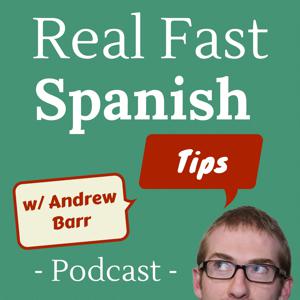
The Real Fast Spanish Tips Podcast
Andrew Barr: Spanish Student, Teacher & Blogger
Your top resource for learning Spanish and achieving a conversational level in Spanish as fast as possible. Information on learning Spanish, tips, vocabulary, grammar and a whole lot more.
- 1 secondSilent Letters in Spanish – A Short But Important List
There are only 2 regular silent letters in the Spanish language.
But, you’ll need to be careful with both of these letters because they are silent in some words and pronounced in others.
In addition, when I say ‘regular’ silent letters I’m referring to the pronunciation of traditional Spanish words, not words that have been adopted from Greek or other languages.
In this post, I’ll give an overview of the two silent letters in Spanish including where and how you need to use them.
Since this post is about pronunciation, I’ll also include some short mp3 recordings to demonstrate what the words sound like to avoid any confusion with phonetic spelling.
The letter H
The first silent letter in Spanish is the letter H. This letter is always silent unless it is next to the letter C.
When we see the letter C next to an H we need to make a ch sound. This sound is just like the English ‘ch’ sound in words like ‘cheek’ or ‘beach’.
In the Spanish alphabet, the word that represents the letter H is hache. Since this word starts with an H and has a ch, it makes for a great first example to demonstrate the pronunciation of H and ch.
Hache (aitch)
https://rfs-post-audio-2.s3-us-west-2.amazonaws.com/hache.mp3Here are two more examples of words that also start with H:
Hasta (until)
https://rfs-post-audio-2.s3-us-west-2.amazonaws.com/hasta.mp3Haber (to have)
https://rfs-post-audio-2.s3-us-west-2.amazonaws.com/haber.mp3Here are two examples with the letter H in the middle of the word:
Ahora (now)
(notice how the H creates a ‘gap’ between the A and the O)
https://rfs-post-audio-2.s3-us-west-2.amazonaws.com/ahora.mp3Alcohol (alcohol)
(similarly, notice the H creates an elongation between the two middle O’s) https://rfs-post-audio-2.s3-us-west-2.amazonaws.com/alcohol.mp3To finish the section on the letter H, here are two examples with a ch:
Echar (to throw)
https://rfs-post-audio-2.s3-us-west-2.amazonaws.com/echar.mp3Hecho (fact)
https://rfs-post-audio-2.s3-us-west-2.amazonaws.com/hecho.mp3The letter U
In the majority of Spanish words with a U, the sound you need to make to represent the U is like a double “oo” in English and rhymes with the English word “too”.
Here are two examples of words with the typical pronunciation of the Spanish letter U:
Lugar (place)
https://rfs-post-audio-2.s3-us-west-2.amazonaws.com/lugar.mp3Mucho (a lot)
https://rfs-post-audio-2.s3-us-west-2.amazonaws.com/mucho.mp3In contrast, the letter U is silent in Spanish words when it is next to a Q or sandwiched in between a G and an E or a G and an I as gui and gue.
Here are some examples with U after a Q:
Porque (because)
https://rfs-post-audio-2.s3-us-west-2.amazonaws.com/porque.mp3Pequeño (small)
https://rfs-post-audio-2.s3-us-west-2.amazonaws.com/pequen%CC%83o.mp3Here are some examples with a gui:
Guión (script)
https://rfs-post-audio-2.s3-us-west-2.amazonaws.com/guio%CC%81n.mp3Seguir (to follow)
https://rfs-post-audio-2.s3-us-west-2.amazonaws.com/seguir.mp3Here are some examples with a gue:
Guerra (war)
https://rfs-post-audio-2.s3-us-west-2.amazonaws.com/guerra.mp3Llegué (I arrived)
(the tilde on the E means you need to pronounce this word with an emphasis on the second syllable)
https://rfs-post-audio-2.s3-us-west-2.amazonaws.com/llegue%CC%81.mp3To make things slightly more confusing, whenever you see a Ü in Spanish with a double dot, you need to pronounce the U sound. You will see this letter in situations like the last two examples as either a güe or a güi.
Here are some examples with a güi:
Pingüino (penguin)
(Notice how the güi sounds like “gwee”)
https://rfs-post-audio-2.s3-us-west-2.amazonaws.com/pingu%CC%88ino.mp3Lingüística (linguistics)
https://rfs-post-audio-2.s3-us-west-2.amazonaws.com/lingu%CC%88i%CC%81stica.mp3Here are some examples with a güe:
Vergüenza (embarrassment)
(Notice how the güe here sounds like “gwen”)
https://rfs-post-audio-2.s3-us-west-2.amazonaws.com/vergu%CC%88enza.mp3Bilingüe (bilingual)
(Notice how the güe here sounds like “gwe”)
https://rfs-post-audio-2.s3-us-west-2.amazonaws.com/bilingu%CC%88e.mp3Adopted silent letters from other languages
At the start of the post, I mentioned that there are silent letters that occur in words that have been adopted from other languages such as Greek.
Here are a few examples:
- The m in mnemotecnia (mnemonics).
- The p in pterodáctilo (pterodactyl).
- The p in psicólogo (psychologist).
These are fairly low use words so I don’t recommend you spend too much time on them (unless you are a psychologist and need this word to explain what you do).
Your Turn
Choose some examples from this post and practice the pronunciation by copying recordings. Also, try them out with a Spanish native in a language exchange or with a teacher.
As a bonus for reading this post, if you sign up to the Real Fast Spanish School and mention this post in an email, I will offer you a free one-on-one Skype lesson as another opportunity to practice your pronunciation.
If you would like to learn more about pronunciation check out this podcast episode.
How can you remember the silent letters in Spanish?

The post Silent Letters in Spanish – A Short But Important List appeared first on Real Fast Spanish.
21 January 2016, 1:42 pm - 24 minutes 16 secondsTips 116: La Vida Te Cambia
Imagine your partner says to you that as a couple you should move together to the other side of the world to start a new life. Could you do it? Would you do it?
This week we talk to Cristina Orts about her experience of moving to a new country that doesn’t speak her language.
These days, Cristina is comfortable in her new environment. But there was a point where she almost didn’t come. And the thing that nearly stopped her was something that affects all of us.
In the episode, we will explore Cristina’s story. We start the story at the point where her partner Borja proposes that they should move to Australia to experience a different way of life.
Cristina’s initial reaction was to say yes (‘vale’) but when Borja started looking at flights, things started to get real and Cristina had to come clean about what she was really thinking.
Later we discover how Cristina overcame her fears and after going through the experience we learn what advice Cristina would give her younger self or anybody who is considering a move to another country.
If you are having trouble understanding the Spanish section of the podcast or if you would like to get more out of the podcasts and take your Spanish to next level you can get access to the accompanying Spanish podcast transcripts in The Real Fast Spanish School here.
What advice would you give if someone said they were afraid to move to a new country?
The post Tips 116: La Vida Te Cambia appeared first on Real Fast Spanish.
24 September 2015, 1:59 pm - 28 minutes 32 secondsTips 115: Life in Madrid with Daniel Welsch – Part 2
This episode of the podcast is part 2 of a two-part interview with Daniel Welsch.
If you missed part 1 of the interview you go back and listen to it here.
Daniel has some great advice for Spanish students or language students in general. He has a lot of experience teaching English and talked about some of the challenges for his students learning English. This information is great as you may find yourself in a situation where you also want to teach English while you travel.
He has been living in Madrid for more than 10 years and shares some great advice around what you need to know if you are planning a move to Spain.
In this second part of the interview we talk about:
- How movie translations from English to Spanish or Spanish to English are often strange. We talk about how the decision of what to call a movie is often based on the cultural context of the title.
- The merits of dubbing and subtitles and how popular TV from the US is prepared for a Spanish audience.
- Daniel gives a few suggestions for some books to read and includes his favourite Spanish book of all time (see resources below).
- Daniel provides some guidance on how you could plan an upcoming trip to Spain. I give him the framework of what to see and do if you only had 1 day, 1 week or 1 month.
- We ‘geek-out’ a little bit on Spanish food and how you should approach the food in Spain with an open mind.
- Daniel provides some great advice on what you need to know if you want to move to Spain and live there as an ex-pat.
Resources mentioned in part 1 of the interview:
- Daniel’s favourite book: Dulce Chacón – La Voz Dormida
.
- The movie mentioned: Ocho Apellidos Vascos.
- Daniel’s favourite movie: “Bienvenido Mister Marshall” by Luis Garcia Berlanga.
- Finding accommodation in Spain: idealista.com and fotocasa.es.
- Daniel’s website: AprendeMasIngles.com.
- Daniel’s ex-pat blog: ExpatMadrid.com.
What did you learn from the second part of the interview with Daniel Welsch?
The post Tips 115: Life in Madrid with Daniel Welsch – Part 2 appeared first on Real Fast Spanish.
19 July 2015, 11:24 am - 28 minutes 42 secondsTips 114: Life in Madrid with Daniel Welsch
Ever considered an ex-pat life in Spain? This week you will hear from Daniel Welsch who has been living in Madrid for more than 10 years.
I’m very excited to welcome Daniel to the podcast. It is great to talk to someone who has focused solely on Spanish and immersed himself in the culture. This interview is a great opportunity to focus not only on some of the themes of language learning mindset but the mindset associated with a move to a Spanish speaking country.
In the interview, you will hear about some of Daniel’s thoughts on language learning and adapting to life outside of the United States.
In this first part of the interview we talk about:
- How Daniel got his start with Spanish.
- How a 2 week trip to Spain turned into a 10 year stay.
- What is it like to transfer Spanish of Mexico to Spanish of Spain and how Daniel initially dealt with transferring his knowledge of Spanish from another Spanish region of the world.
- Daniel’s approach to making mistakes and getting used to feeling silly. Daniel talks about how life maybe to short to worry about whether your Spanish is perfect or not.
- Daniel has also worked as an English teacher and he talks about some the struggles of his students from Spain have with their English.
- Some of the problems with literal translation and how this applies to going from English to Spanish or the other way round.
- How you can see a variety of Spanish accents change from different regions of Spain.
- I ask Daniel what is the best thing about living in Spain.
- I then ask Daniel what is the worst thing about living in Spain.
- We finish the first part of the interview talking about Spanish cinema.
Resources mentioned in part 1 of the interview:
- Daniel’s favourite movie: Jamón Jamón.
- Another favourite movie: Bienvenido, Mister Marshall.
- The famous spanish director we mentioned in the interview: Pedro Almodóvar.
- Daniel’s website: AprendeMasIngles.com.
- Daniel’s expat blog: ExpatMadrid.com.
What did you learn from the first part of the interview with Daniel Welsch?
The post Tips 114: Life in Madrid with Daniel Welsch appeared first on Real Fast Spanish.
29 June 2015, 12:14 pm - 15 minutes 40 secondsTips 113: An Insider’s Guide to the Canary Islands
One question you have to ask yourself if you are learning Spanish is: which accent should you focus on? How do you choose an accent? Does it matter?
In this week’s theory podcast I interview Alba del Pino. Alba is from the Canary Islands. Her accent is distinctly different to the accent of the rest of Spain.
Having said that, there are subtle differences in the accents of the separate regions from within mainland Spain. But, the way the ‘c’ and ‘z’ is pronounced in the Canary Islands is much closer to the accents of South America than those of Spain.
One point worth noting is that despite the differences in accent and lexicon of all of the separate countries of the Spanish world, even if you are only focused on one region while learning, you will be able to speak to anybody from any country.
I have spent the majority of my Spanish journey practicing with the Spanish of Spain. But I have never had any real trouble speaking with people from the Dominican Republic, Peru, Columbia, Argentina or Mexico. Yes there are subtle differences in accents and vocabulary but they are rarely a barrier to communication. You can think about the the differences between the English of Australia and the English of the United States—rarely is this difference big enough barrier to make conversation difficult.
Listen to today’s podcast to get a sample of the accent from the Canary Islands and see if you can notice some of the differences.
If you are having trouble understanding the Spanish section of the podcast or if you would like to get more out of the podcasts and take your Spanish to next level you can get access to the accompanying Spanish podcast transcripts in The Real Fast Spanish School here.
Difficult vocabulary from the Spanish conversation:
Lexicon – Léxico.
Is it the same lexicon? – ¿Es el mismo léxico?
The kitchen / cuisine – La cocina.
What is the cuisine like in the Canary Islands – ¿Cómo es la cocina de las islas canarias?
Canary Islands flour – El gofio.
Canary Islands cream sauce – El gofio escaldado.
It is the most populated? – ¿Es lo más poblada?
Autonomous region – Comunidad autónoma.
El teide – highest mountain in Spain.
The peak – La cima.
The mountainside – La falda (la falda de la montaña).
What did you learn from today’s podcast on the Canary Islands?
The post Tips 113: An Insider’s Guide to the Canary Islands appeared first on Real Fast Spanish.
25 June 2015, 11:23 am - 9 minutes 10 secondsTips 112: The Power of Noticing
How much do you notice? Actually notice?
Did you know that the ability to notice is a skill that can be improved? And that you can use that ability to improve your language learning capacity?
This week’s mindset podcast is inspired by the book:
Alexandra Horowitz — On Looking: 11 Walks with Expert Eyes
This book is a fascinating read. It highlights how a narrow vision can limit your ability to see the things that are happening all around you.
The premise of the book is simple. The author would take 11 walks around the city book with some carefully selected “experts”. Each “expert” would allow her to see through their eyes, helping her to notice things that she could never have seen without the expert’s help.
Expert is a term that is loosely applied as the first walk is with her toddler and the second walk is with her dog.
What Horowitz discovers walking her city block with experts such as a geologist, a doctor, a psychologist or a typographer is that there is a narrative that is happening all around that we rarely see. The history in a block of sandstone. The bug-eating away at a small leaf. The slightly lopsided gate of a fellow pedestrian. Or the subtle lettering on a street sign. All of these things have a story and say something about the world and without growing our ability to notice, there are hundreds of stories that we may never see of experience.
Apart from being a fascinating and eye-opening read, if you can take away the idea of looking to improve your ability to notice it can help you in two ways:
- It can help you stay present and avoid spending unnecessary time fretting about things that you cannot control.
- It can help you improve your rate of learning.
Both of these aspects of noticing things in the moment will improve your ability to learn a second language.
In today’s mindset podcast you will learn about the book, the ideas and some of the takeaways that you can test and apply for yourself this week.
Try the techniques for yourself and see if they help you with your ability to stay present when practising your Spanish. See if you can notice how a Spanish native speaks—the tone of their voice, the movement of their hands or the use of particular words.
The mindset challenge for you this week is to see if you can notice something that you have never noticed before on your city block. And for an additional challenge, see if you can notice yourself noticing things—this last test will really help with present state awareness.
Previous episodes mentioned in this episode:
- 4 Tricks To Lift Your Spanish Using Body Language.
- How to Set Yourself for Language Learning Success with John Fotheringham (Part 1 of 2).
- How to Set Yourself for Language Learning Success with John Fotheringham (Part 2 of 2).
How else can you apply the idea of “noticing” to improve your language learning skills?
The post Tips 112: The Power of Noticing appeared first on Real Fast Spanish.
22 June 2015, 11:47 am - 12 minutes 50 secondsTips 111: Common Spanish Verbs – 6 Uses for the Verb “Acabar”
Can you explain when you use “to end” and “to finish” in English? If so, you can apply the idea to the Spanish verbs “acabar” and “terminar”.
This week’s Spanish theory episode is dedicated to the common spanish verb “acabar”.
In many of the examples in today’s podcast the Spanish verb “terminar” and “acabar” are interchangeable. But, just like in English, there are a few situations when you can only use one or the other.
In today’s podcast you will find out how to use ‘acabar’ in a conversation and some of it’s important uses with Spanish prepositions. If you have any questions, you can leave them below.
If you want to be conversational in Spanish, check out The Real Fast Spanish School. In the school, you can access all of the training at Real Fast Spanish designed to help you reach a conversation level of Spanish as effectively as possible.
Examples from today’s podcast:
I finish work at 5 – Termino mi trabajo a las 5.
I finish work at 5 – Acabo mi trabajo a las 5.
I don’t like how the movie ends – No me gusta cómo acaba la película.
Sofia and I are ended – Sofia y yo hemos acabado.
The word ‘university’ ends in the letter D – La palabra ‘universidad’ acaba en la letra D.
The dinner ended in drinks until 3 am – La cena acabó en copas hasta las 3 de la madrugada.
My trip to Europe ended in Paris – Mi viaje a Europa acabó en París.
I just finished my homework – acabo de terminar mis deberes.
She just called the doctor – Ella acaba de llamar al médico.
I just do not understand – No acabo de entenderlo.
Guys just don’t understand women – Los chicos no acaban de entender las mujeres.
He ended up working at McDonalds – Él acabó trabajando en McDonalds.
After much sacrifice and dedication, he ended up being a very famous actor – Después de mucho sacrificio y dedicación, él acabó siendo actor muy famoso.
My boss ended the discussion by slamming a fist on the table – Mi jefe acabó con la discusión en un golpe en la mesa.
Police ended the drug problem in my neighborhood – la policía acabó con el problema de la droga en mi barrio.
Teacher comments ended my hopes of passing the exam – Los comentarios del profesor acabaron con mis esperanzas de aprobar el examen.
How else can you use the Spanish verb “acabar” in a conversation?
The post Tips 111: Common Spanish Verbs – 6 Uses for the Verb “Acabar” appeared first on Real Fast Spanish.
18 June 2015, 12:59 pm - 37 minutes 50 secondsTips 110: How to Set Yourself for Language Learning Success with John Fotheringham (Part 2 of 2)
 In today’s mindset podcast you will hear part 2 of the two part interview with John Fotheringham. In the second part of the interview we discuss how to manage frustration due to a lack of progress. We talk about what separates a good language learner from a great language learner. And we debate the merits of the language learning classroom and how you can get the most out of one.
In today’s mindset podcast you will hear part 2 of the two part interview with John Fotheringham. In the second part of the interview we discuss how to manage frustration due to a lack of progress. We talk about what separates a good language learner from a great language learner. And we debate the merits of the language learning classroom and how you can get the most out of one.You can learn more from John at Langauge Mastery—a language learning blog and podcast dedicated to helping language learners. The focus of his website is 80% on general language learning and 20% on Mandarin and Japanese.
If you missed part 1 of the interview you go back and listen to it here.
These mindset podcasts are about exploring topics outside of Spanish vocabulary or grammar. They are useful because because ultimately they will help you achieve your goals with learning Spanish more effectively.
In this second part of the interview we talk about:
- How to manage the frustration of feeling like you have a long way to go to reach your language goals. John offers a great tip for overcoming the feeling that you are a long way away from where you would like to be.
- What separates a great language learning from a good language learner.
- What role passion plays in language learning and what can you do to build your passion for language learning.
- Why humility is important in language learning. How to deal with making mistakes and why it is important to leave your ego at the door.
- John’s thoughts on the language learning classroom and how to get the best out of a classroom if you find yourself in one.
- What a famous Bruce Lee quote means to John and how you can apply it language learning.
- How to improve your pronunciation.
- What John’s life would look like without language learning in it?
- In the end, John gives a great metaphor for why language learning is like putting on Scuba Gear.
What did you learn from the second part of the interview with John Fotheringham?
The post Tips 110: How to Set Yourself for Language Learning Success with John Fotheringham (Part 2 of 2) appeared first on Real Fast Spanish.
15 June 2015, 10:30 am - 12 minutes 10 secondsTips 109: How to Use the Spanish Verb “Hay”
“Hay” is a unique Spanish verb. It is related to the verb “haber” or commonly referred to as the impersonal form of “haber”.
In today’s podcast, you will learn how to use the verb “hay” in the past, present and future. You will also learn how to use the impersonal phrase with the verb “hay” to express obligation.
Check out today’s podcast for all of the details. If you have any questions or thoughts you can leave a comment below.
If you want to be conversational in Spanish, check out The Real Fast Spanish School. In the school, you can access all of the training at Real Fast Spanish designed to help you reach a conversation level of Spanish as effectively as possible.
Examples from today’s podcast:
There is a lot of noise here – Hay mucho ruido aquí.
Is there a good place to eat around here? – ¿Hay un buen lugar para comer por aquí?
Is there a good place to drink something around here? – ¿Hay un buen lugar para tomar algo por aquí?
Is there a good place to speak around here? – ¿Hay un buen lugar para hablar por aquí?
There was a party in the apartment upstairs last night anoche. It was very noisy. – Hubo una fiesta en el piso de arriba anoche. Fue muy ruidosa.
Last week there was a day I’m never going to forget – La semana pasada hubo un día que nunca voy a olvidar.
When I was little there were very fun moments – Cuando era pequeño había momentos muy divertidos.
We laughed at a joke that there was between us – Nos reímos de una broma que había entre nosotros.
Next week there will be a church wedding – La semana que viene habrá una boda en la iglesia.
In the future there will be cars that can fly – En el futuro habrá coches que pueden volar.
One must not tell lies – No hay que decir mentiras.
If one wants to speak Spanish one has to practice every day – Si se quiere hablar español hay que practicar todos los días.
Other episodes mentioned in this podcast:
How else can you use the Spanish verb “hay” in a conversation?
The post Tips 109: How to Use the Spanish Verb “Hay” appeared first on Real Fast Spanish.
11 June 2015, 1:03 pm - 38 minutes 18 secondsTips 108: How to Set Yourself for Language Learning Success with John Fotheringham (Part 1 of 2)

In this week’s mindset podcast we welcome John Fotheringham to talk about habit forming, how to set goals for success and one aspect of language learning that rarely gets discussed.John is a passionate language learner and is running Langauge Mastery—a language learning blog and podcast dedicated to helping language learners. The focus of his website is 80% on language learning and 20% on Mandarin and Japanese.
On top of his experience in language learning, more recently, John has been developing his knowledge on nutrition. I asked John on to the podcast to talk about the topic of nutrition because it is an important aspect of performance. If you aren’t sleeping right or your aren’t eating right, you aren’t setting yourself up for success in language learning.
These mindset podcasts are about exploring topics outside of Spanish vocabulary or grammar. They are useful because because ultimately they will help you achieve your goals with learning Spanish more effectively.
In this first part of the interview we talk about:
- Nutrition and how you can improve your diet to improve your memory and ability focus and form successful habits.
- John’s first experience language learning in Brazil as a 12 years old.
- His experiences in France in his senior year of high school
- How is true love of language learning began with Japanese in college.
- Some of John’s struggles with the language gap in Japan.
- We cover some of John’s observations of the cultural experience in Japan.
- How you should think about priorities instead of maximising and managing your time.
- How to set yourself up for success by setting tiny, achievable goals.
- How to break up tasks to the minimum for focus.
- What it is like to work as a translator.
- John then explains how working as a translator and transferring those skills to having conversations doesn’t work as well as you might expect.
What did you learn from the first part of the interview with John Fotheringham in this mindset episode?
The post Tips 108: How to Set Yourself for Language Learning Success with John Fotheringham (Part 1 of 2) appeared first on Real Fast Spanish.
8 June 2015, 1:27 pm - 13 minutes 51 secondsTips 107: 8 Uses of Ser and Estar with Adjectives
The uses of Ser and Estar are an important part of Spanish that you should always be revising.
In today’s podcast, you will learn about one specific part: the uses of ser and estar with adjectives.
As a reminder, ‘ser’ tends to imply a permanent feature and ‘estar’ tends to imply a temporary feature. Keep this in mind as you listen to the examples for today.Examples from today’s podcast:
Elena is a good person, she always gives to the poor – Elena es buena, ella siempre da a los pobres.
This wine is of high quality – Este vino es muy bueno.
This gazpacho tastes great / amazing – Este gazpacho está buenísimo.
The boy is very attractive. He is tall, dark and his body is incredible – El chico está muy bueno. Es alto, moreno y el cuerpo está increíble.
I don’t like your friend he is a bad (person) – No me cae bien tu amigo, él es malo.
The Paella is cheap because it is low quality – La paella es barata porque es muy mala.
Sonia has spent all day in bed she is very sick – Sonia ha pasado todo el día en la cama, ella está muy mala.
This chicken is bad, I don’t like it – Este pollo está malo, no me gusta.
Christy Walton is the richest women in the world – Christy Walton es la mujer más rica del mundo.
The churros are so good – Los churros están tan ricos.
Your sister is very intelligent – Tu hermana es muy lista.
I’m still not ready. I need five more minutes – Todavía no estoy listo. Necesito 5 minutes más.
My car is green – Mi coche es verde.
Paco es green, he needs to keep learning – Paco está verde, tiene que seguir aprendiendo.
The apple is unripe – La manzana está verde.
The shirt is black – La camisa es negra.
I’m angry because the house is dirty – Estoy negro porque la casa está negra.
María is very open, she usually speaks to everyone at the party – María es muy abierta, ella suele hablar con todo el mundo en la fiesta.
Who left the door open? – ¿Quien dejó la puerta abierta? (La puerta está abierta)
Andrés is very closed he doesn’t speak to anybody – Andrés es muy cerrado, no habla con nadie.
The restaurant is closed, it normally opens at seven – El restaurante está cerrado, normalmente abre a las siete.
Other episodes mentioned in this podcast:
How else can you ser and estar with adjectives?
The post Tips 107: 8 Uses of Ser and Estar with Adjectives appeared first on Real Fast Spanish.
4 June 2015, 12:21 pm - More Episodes? Get the App
Your feedback is valuable to us. Should you encounter any bugs, glitches, lack of functionality or other problems, please email us on [email protected] or join Moon.FM Telegram Group where you can talk directly to the dev team who are happy to answer any queries.

 The Spanish Dude Podcast (Audio)
The Spanish Dude Podcast (Audio)
 Learn 15 Minute Spanish for your Job Podcast
Learn 15 Minute Spanish for your Job Podcast
 Spanish Grammar Review
Spanish Grammar Review
 Lightspeed Spanish - Beginners Spanish Lessons
Lightspeed Spanish - Beginners Spanish Lessons
 Early Intermediate – Lightspeed Spanish
Early Intermediate – Lightspeed Spanish
 Learn Spanish: Podcast de My Spanish Podcasts
Learn Spanish: Podcast de My Spanish Podcasts